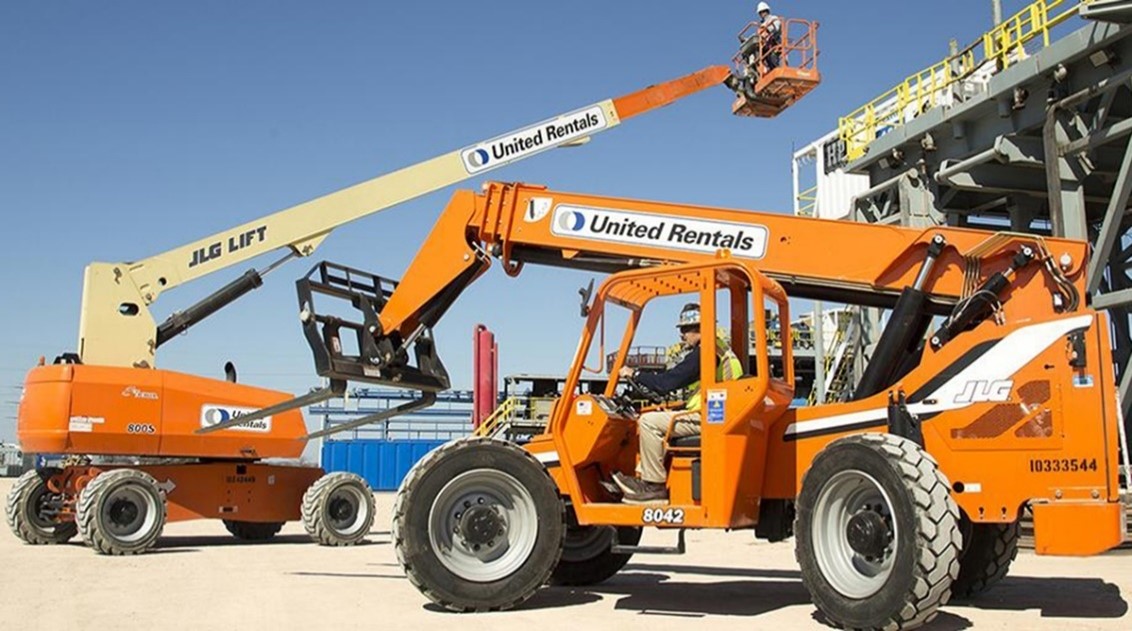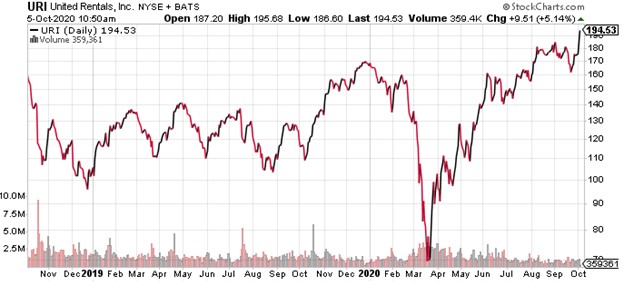United Rental Has Transformed into a Digital Powerhouse
Businesses in every sector all around the world are being transformed by data, and in the process, investors are creating a new class of digital winners like United Rentals, Inc. (NYSE: URI, Rated “C+”).
The giant equipment rental company was one of 38 companies recommended by Morgan Stanley (NYSE: MS, Rated “C+”) on Thursday. Analysts believe United Rentals is a technology value creator with bright prospects.
It’s a really good bet.

Equipment rental might not be at the top of your mind when you think of digital transformation. However, all businesses are moving toward new models informed by data analytics and a coming deluge of digital information.
United simply became the first and biggest mover in its industry, especially now that business is set to explode as more companies move away from equipment ownership.
Analysts at McKinsey and Co., a global business management consulting group, believe this kind of digital transformation could create $3.7 trillion in value by 2025.
Related post: Dell Is at it Again
It’s easy to see how that could be true. In the same way that cloud computing providers and firms delivering software-as-a-service disputed data processing and essential software, United is doing the same thing to traditional ownership models for heavy machinery.
United rents large equipment used by industrial, commercial and residential construction businesses. Bulldozers, mining excavators, tower cranes, graders, dump trucks and other heavy machinery is expensive to buy, maintain, insure and transport between jobsites. Worse, the equipment might not be in use every day, further adding to the cost of ownership.
A simple contract with the Stamford, Conn.-based United simplifies everything.
Workers get the well-maintained equipment when they need it, for as long as they need it. Compartmentalizing this cost isn’t just an accounting trick, it can dramatically improve the efficiency of cyclical businesses by making them leaner, in the same way renting data storage and computer processing from Amazon.com, Inc. (Nasdaq: AMZN, Rated “B”) negates the cost of building and maintaining data centers.
But this alone is not why United shares are set to boom in the years ahead. Like other forwarding looking companies, United managers invested early in cutting edge technologies and have been gobbling up competitors to build overwhelming scale.
Its full equipment fleet is 640,000 units strong across 1,169 locations in the United States and Canada. Inventories are meticulously monitored with cutting edge telematics systems.
And its Total Control system is a cloud-based equipment management tool that allows clients the flexibility to access and rent equipment with a few mouse clicks. It’s fully digital and on-demand, available 24/7. Purchasing managers even get benchmarks to show hypotheticals for delaying or advancing rental decisions. The changes could result in savings of thousands of dollars per day.
With $9.35 billion in sales during 2019, United is now the largest equipment rental business in the world. It’s also extremely profitable. Margins were 46.6% last year, resulting in net income of $4.36 billion, with plenty of free cash flow.
Related post: Cadence Design Systems Is a Hidden Gem
That’s far cry from its 2007 initial public offering when sales amounted to only $60 million.
During the last two decades, United managers have been dutifully following a growth plan. They engineered 279 acquisitions. In most cases the buyouts were immediately accretive as smaller regional rental businesses were folded into the larger United network. Slowly, the company began to build overwhelming scale. They negotiated better purchase prices for equipment, then undercut competitors. And a holistic approach to backend software systems has reign-in costs, too.
It’s one of the big takeaways at Morgan Stanley.
In a Thursday note to clients, “What’s Technology Worth: Introducing Data Era Stocks 2.0”, analysts pointed out that there are 38 companies with key technology edges that should help close the valuation gap between conventional tech stocks and the rest of the market.
Relative to their peers, these businesses already have high profit margins, trade at higher multiples to their forward earnings (1.7 times) and have spent more on capital expenditures than their peers.
The Morgan Stanley researchers expect United and others will ultimately be rewarded with multiples 5 times the market as investors begin to move money into these emergent technology/industry/retail hybrids.
United shares trade at only 11.2 times forward earnings and 1.4 times sales. The stock is on the verge of a new upside breakout and could trade to $270 during the next 12 months on the basis of sales growth alone. This is a gain of 45% from current levels.
Investors should consider buying United shares into any near-term weakness.
Best wishes,
Jon D. Markman


